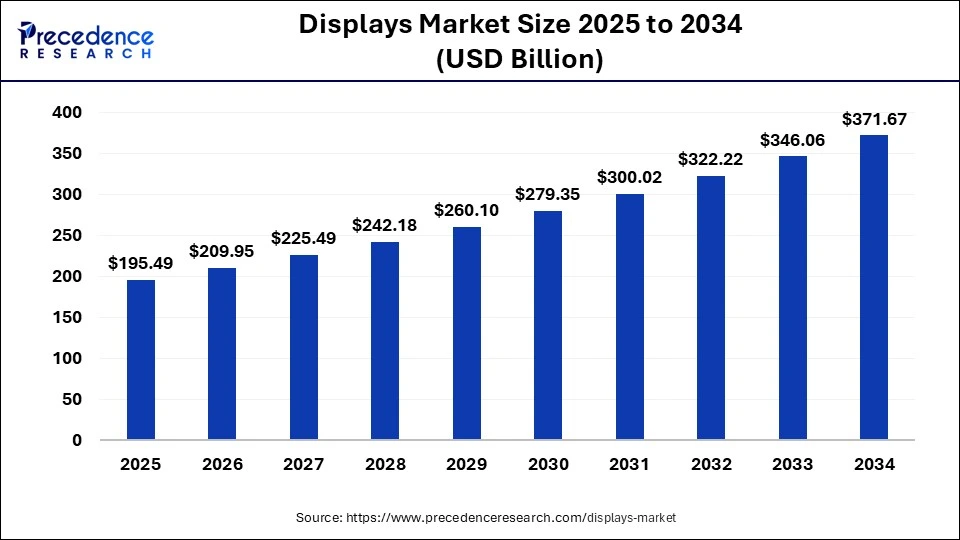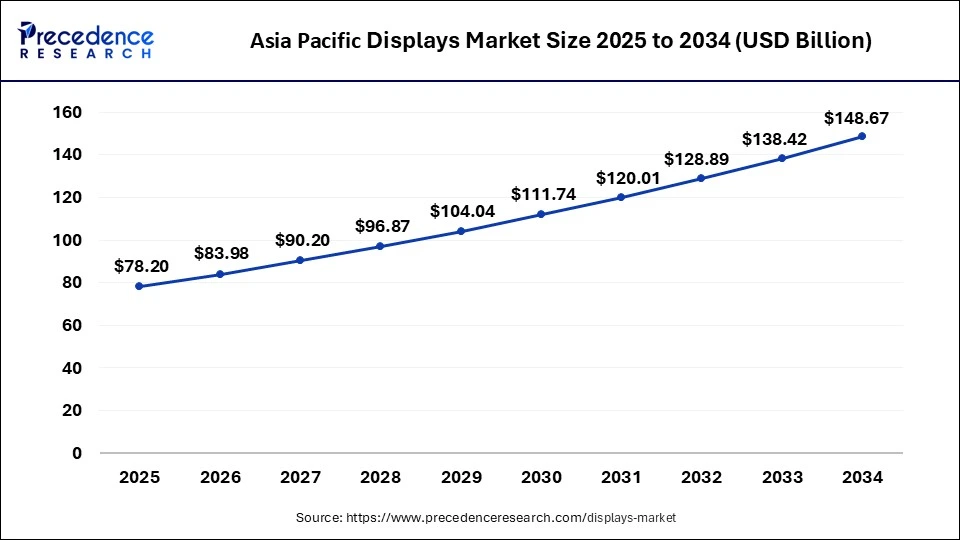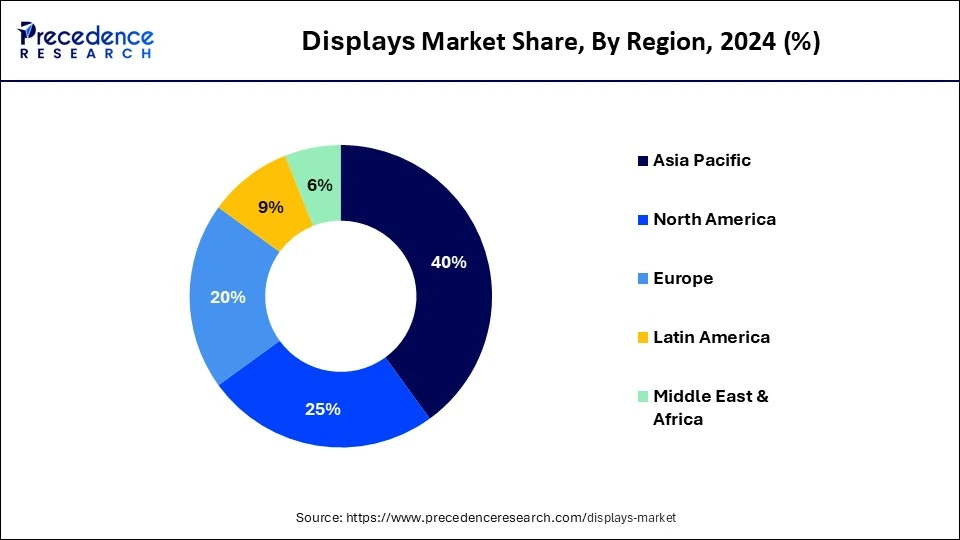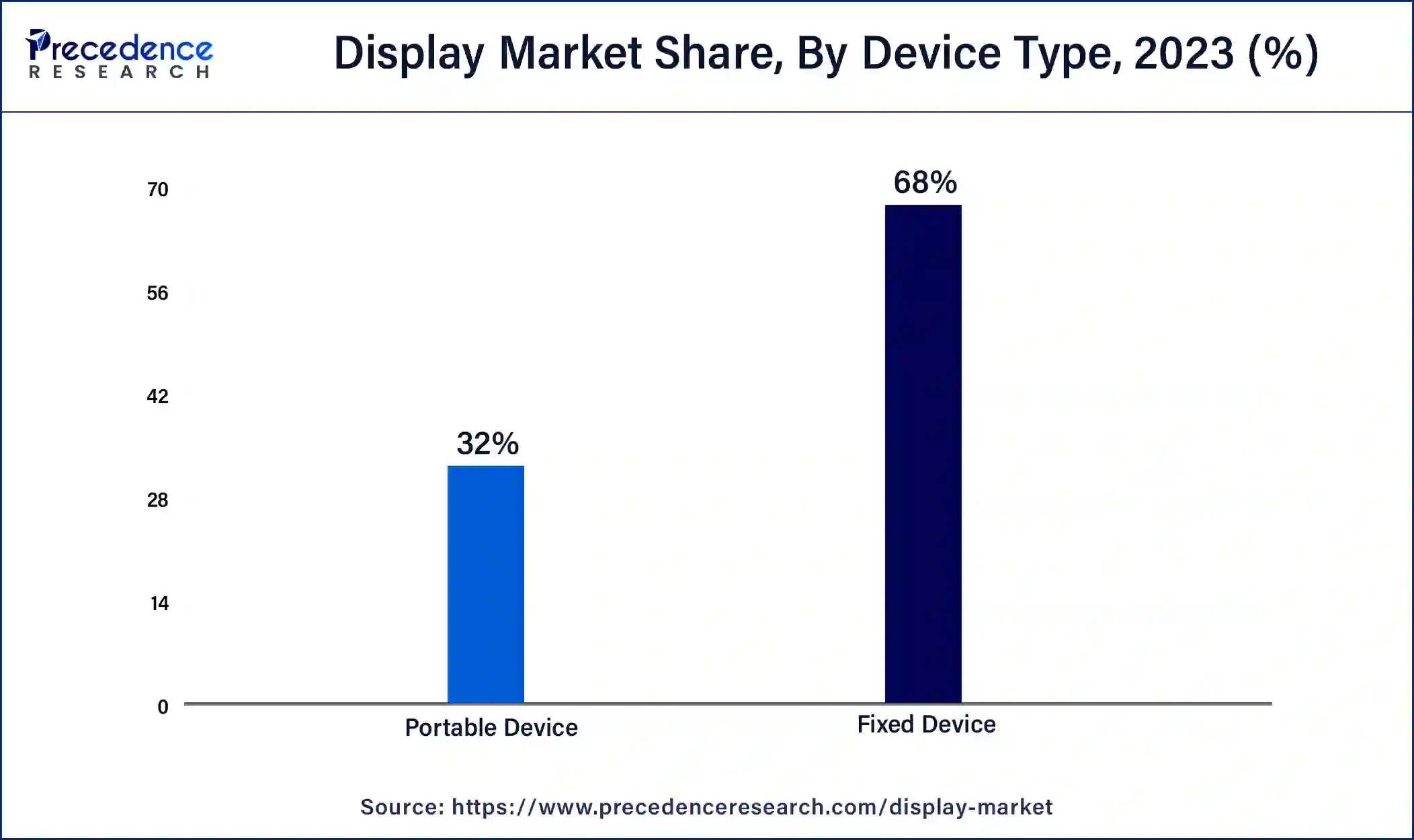List of Contents
Display Market Size and Growth 2025 to 2034
The global display market size accounted for USD 182.02 billion in 2024 and is expected to reach around USD 371.67 billion by 2034, expanding at a CAGR of 7.4% from 2025 to 2034.

Display Market Key Takeaways
- Asia Pacific led the global market with the highest market share of 40% in 2024.
- By display type, the flexible displays segment has held the largest market share in 2024.
- By technology, the LCD technology segment captured the biggest revenue share in 2024.
- By product, the smartphone segment registered the maximum market share in 2024.
- By device type, the fixed device segment is estimated to hold the highest market share in 2024.
Asia Pacific Display Market Size and Growth 2025 to 2034
The Asia Pacific display market size was estimated at USD 72.81 billion in 2024 and is predicted to be worth around USD 148.67 billion by 2034, at a CAGR of 7.6% from 2025 to 2034.

In 2024, APAC will hold a 40% share of the global display market. The industry-level research and development efforts in North America are constantly growing and advancing automated embedded device technology, which is raising the adoption rate of Display devices in industries including as healthcare, automotive, industrial, defence, and others. The market is anticipated to be stimulated by the huge number of end device makers in APAC. Since emerging nations like India, Japan, China, and others are constantly expanding the use of displays in a variety of industrial verticals, including wearables, smartphones, digital signage, medical, automotive, and other areas, the APAC region is thought to have the fastest growth for liquid crystal displays.

Other factors contributing to the market's growth in the area include the expansion of display panel production facilities and the quick uptake of OLED displays. APAC has low labour expenses, which lowers the overall cost of producing display panels. The market is also being supported by the increasing use of display devices across a variety of sectors, particularly in China, India, and South Korea.
Market Overview
Screens that project information like pictures, movies, and messages are referred to as displays. Numerous technologies, including light-emitting diodes (LEDs), liquid crystal displays (LCDs), organic light emitting diodes (OLEDs), and others, are used in these display panels. Additionally, it plays a significant role in consumer electronics including TVs, computers, tablets, laptops, smart watches, and others. Consumer electronics, retail, sports & entertainment, transportation, and other business verticals all benefit from improved visualisations brought forth by the development of modern technology. In the consumer electronics and entertainment industries, 3D displays are popular. Additionally, flexible display technologies are becoming more and more common.
Furthermore, display technologies like organic light-emitting diode (OLED) have become more crucial in items like televisions, smart clothing, cell phones, and other gadgets. In order to draw customers, smartphone makers also want to use flexible OLED screens. In addition, the market is also developing energy-saving gadgets, mainly for wearable technology. Presently, a wide range of industries, including those in the entertainment, business, transportation, retail, hospitality, education, and healthcare, among others, employ a lot of displays. These make it possible for organisations to interact with a larger audience. A centralised network for digital communications is also facilitated by them. With capabilities like touch screen as well as non-touch screen combined with intelligent graphical user interface, displays are quick to execute colour and organic light emitting diode and liquid crystal display interfaces. It is made up of hardware and software, and embedded software is what makes displays compatible with it.
Growth Factors
The worldwide display market is expanding as a result of advancements in flexible displays, rising OLED display device demand, and the growing popularity of touch-based devices. However, barriers to market expansion include the expensive cost of cutting-edge display technologies like quantum dot and transparent displays, as well as the stalling growth of desktop, notebook, and tablet PCs. In addition, substantial development possibilities for the global display market are anticipated from new applications in flexible display technologies.
One of the key reasons fuelling the growth of the display market is the rise in demand for digital product and service promotion to get the attention of the target audience. The emergence of smart wearable gadgets, technical developments, and rising demand for OLED-based goods are all contributing to the market further.
The rise in demand for 4K digital sign displays with inbuilt media players and software accelerates market demand.
Market Scope
| Report Coverage | Details |
| Market Size in 2025 | USD 195.49Billion |
| Market Size in 2024 | USD 182.02 Billion |
| Market Size by 2034 | USD 371.67 Billion |
| Growth Rate from 2024 to 2034 | CAGR of 7.40% |
| Base Year | 2024 |
| Forecast Period | 2025 to 2034 |
| Segments Covered | Display Type, Technology, Product, Industry, End Use, and Regions |
| Regions Covered | North America, Asia Pacific, Europe, Latin America, Middle East and Africa |
Technologically Advanced Products
Innovative items like leak detecting systems, home monitoring systems, and complex financial solutions are starting to appear, which has an additional impact on the industry. The industry is growing thanks to the use of organic light-emitting diode panels in televisions and smartphones. Additionally, the display market benefits from rising urbanisation, a shift in lifestyle, an increase in expenditures, and higher consumer spending.
Increase in the use of automated equipment
The adoption of automated equipment by many industries for a variety of uses has a significant influence on displays, which are available with high efficiency at cheap cost and are anticipated to accelerate market expansion. Because they offer a long lifespan, great scalability, high intensity, high brightness, and more, embedded devices are widely utilised. The organic light emitting diode and liquid crystal display markets are supported by aspects like reasonable pricing, effective brightness, and longer life and are expected to expand at the quickest rate in the industry over the projected period. The increased usage of Displays by the healthcare, educational, and automotive sectors is anticipated to fuel market expansion.
Greater Use of Displays in 3D Systems
The usage of Displays in 3D systems is another factor boosting the market's expansion. The user can employ the sophisticated technologies in Displays for the 3 systems due to their quick development. The market is anticipated to increase significantly as a result of the adoption of 3D systems in the consumer, industrial, medical, automotive, and other sectors. These systems require displays to project the dimensions.
Growing Demand for Flexible Display enabled Technology Consumer Electronic Devices
The flexible display technology has several benefits over rigid standard displays, which are often heavier. These benefits include light weight, flexibility, brightness, low power consumption, and shatter proofness. There are several consumer electronics products that employ these screens. The consumer electronics industry is expanding due to rising demand for products including smartphones, TVs, laptops, smart wearables, and other display devices.
Rise in Trend of Touch-based Devices
Since touch-based gadgets are more accessible, the number of devices with touch sensors has grown tremendously in recent years. The proliferation of display devices is aided by the fact that touch-based gadgets need a display panel to function. As a result, a broad variety of home appliances, including the refrigerator, washing machine, microwave, etc., are enabled with the help of touch screens. The provision of cutting-edge display devices in automobiles, like the navigation system, heads-up display, digital rear-view mirrors, digital dashboard, and others, has also increased in the automotive sector. As a result, the market for displays is expanding due to the move toward touch-based technology.
Display Type Insights
Innovations in flexible displays, a growth in the demand for OLED display products, and a rise in the popularity of touch-based gadgets are what are driving the worldwide display market. However, the market is constrained by the expensive cost of cutting-edge display technologies like quantum dot and transparent displays, as well as the slow expansion of desktop, laptop, and tablet computers. Additionally, new applications for flexible display technologies, which are anticipated to produce profitable growth possibilities, are likely to boost the worldwide display market.
Technology Insights
LCD technology has been widely utilised in display items during the preceding several decades. Currently, a number of settings, including retail, corporate offices, and banks, employ LCD-based gadgets. But it's anticipated that LED technology will advance quickly throughout the course of the predicted period. The development of LED technology and its energy-efficiency are what are driving the demand for it. A disturbance in the supply-demand ratio, a decline in LCD display panel ASPs, and intense competition from emerging technologies are anticipated to push the LCD display sector into negative growth during the course of the projection period.
LED technology is predicted to drive market expansion because to its high pixel-pitch, brightness, improved efficiency, high light intensity, improved power efficiency, extended lifespan, and high scalability. Due to increased usage of displays in the automotive and medical sectors, where LED Displays are being utilised increasingly, the LED display market is anticipated to develop at a large and rapid 6.5% between 2024 and 2034.
Product Insights
The smartphones and tablets segment held the largest share of 31.50% in the 2024 displays market. The continuous use and need for smartphones and tablets have accelerated the growth of this segment. The demand for smartphones and tablets has rapidly increased among all age. This segment has prominently evolved display technology. The development and growth of this segment are driven by its numerous advancements, power stability, and brightness. The traditional mobile devices used LCDs, and modern devices adopted technologies such as AMOLED and OLED. The modern devices provide features such as edge-to-edge and curved displays.
The automotive displays segment is expected to grow at a CAGR of 9.80% during the forecast period. The automotive displays include the center stack display, HUDs, and the instrument cluster. The center stack display in the automotive industry showcases several in-vehicle functions on the dashboard that help to address climate, with its infotainment system. The HUD's head-up displays in automotive reports driving information onto the windshield, and the instrument cluster is a collection of indicators, displays, and gauges situated behind the steering wheel, informing the vehicle's status and performance. The automotive display segment as a market is the second most emerging in the displays industry.
Display Technology Insights
The LCD (Liquid crystal display) segment held the largest share of 38.60% in the 2024 displays market. The LCD is crucial in modern displays, offering the first advantages, such as thin form factors. It operates by influencing the light via liquid crystal molecules. The LCD technology types consist of IPS LCD, TFT LCD, and TN/VA. IPS LCD refers to in-plane switching enables colour accuracy, viewing from wide angles, and provides a quality image. It's inspired by TN (twisted nematic) LCD, identifying issues such as limited viewing angles and colour distortion. The TFT LCD is an active-matrix approach that enhances contrast. It is used in several applications like computer monitors, televisions, smartphones, etc. Vertical alignment (VA) features and operations enable a dark screen without any voltage. The LCD segment is rapidly expanding with various types and a wider range of applications in the global display market.
The OLED (Organic Light Emitting Diode) segment is expected to grow at a CAGR of 10.20% during the forecast period. The active and passive matrix OLEDs are classified and serve the development of OLEDs altogether. The potential to mould flexibly and thin opens up new opportunities in device design. AMOLED with its TFT feature, superior image quality, and PMOLED is affordable and suitable for easy applications such as small displays.
Display Type Insights
The flat panel display segment held the largest share of 62.40% in the 2024 displays market. The flat panel display (FPD) helps interaction with the digital world, providing thin and lightweight effective solutions for several devices. The development is driven by enhancements in display size, features, and quality. Its quality imaging, space-saving designs, and robust applications make flat panels more approachable for display devices.
The flexible display segment is expected to grow at a CAGR of 11.10% during the forecast period. The flexibility of the display settings supports clarity and modification, making it seamless and convenient for customers. Its flexibility is transitioning the display company with its abilities to fold, bend, and roll, supporting new devices built in factors and experience connective experiences.
Industry Vertical Insights
The consumer electronics segment held the largest share of 46.80% in the 2024 displays market. The consumer electronics demand is driven by rapid advancement and the preferences of customers for electronic appliances. The smart technology in modern living has elevated the consumer electronics product, and the display market has also evolved to meet consumer expectations and provide satisfactory experiences. The shared profit from the electronic market to the display companies demonstrates the reach and demand of the electronic industry vertical.
The automotive segment is expected to grow at a CAGR of 9.90% during the forecast period. The trends and development in the automotive industry expect advancement and enhancement in the features and more. The automotive displays, such as HUDs, center stack display, and instrument cluster, elevate quality performance and clarity in viewing, meeting the driving criteria on point. Modern technology has to reach every industry; the automotive industry is steadily developing into the global display market.
Device Type Insights
At 68%, the fixed device is anticipated to have the biggest market share over the projection period. Fixed devices are more widely accepted on the market than portable ones because of their low pricing, high scalability, longer life, contrast, and pixel quality, among other factors.

The aforementioned factors have increased the market adoption of fixed device, which is projected to drive the Display market. Both LED displays and Organic Light Emitting Diode are frequently used in these stationary devices.
Display Market Companies
- Panasonic Corporation (Japan)
- LG Display Co., Ltd (South Korea)
- HannStar Display Corporation (Taiwan)
- AU Optronics Corp. (Taiwan)
- Chi Mei Corporation. (Taiwan)
- SAMSUNG (South Korea)
- SHARP CORPORATION (Japan)
- Schneider Electric (France)
- Siemens (Germany)
- Mitsubishi Electric Corporation (Japan)
- SONY INDIA. (India)
- FUJITSU (Japan)
- Chunghwa Picture Tubes, LTD. (Taiwan)
- Barco.(Belgium)
- BOE Technology Group Co., Ltd. (China)
- Innolux Corporation (Taiwan)
- Advantech Co., Ltd (Taiwan)
Recent Developments
- Samsung Electronics introduced a new 14-meter Onyx Cinema LED screen in February 2020. The HOYTS Entertainment Quarter at Moore Park in Sydney, Australia, is where the Onyx screen is situated. This screen was erected for the first time in Australia.
- Samsung Electronics introduced the QLED 8K in March 2019 as an expansion of its Q900 QLED 8K television line. The recently released TV will come in screen sizes of 65 inches, 75 inches, and 82 inches. Additionally, it will expand its offering to include the most cutting-edge image quality.
- Samsung Electronics launched the first 15.6-inch OLED panel in the notebook industry in January 2019. Additionally, compared to 4K LCD-based displays, the panel will produce richer colours and deeper blacks.
Segments Covered in the Report
By Product
- Smartphones & Tablets
- Laptops & Monitors
- Televisions
- Smart Wearables
- Smartwatches
- Smart Glasses (AR/VR Headsets)
- Automotive Displays
- Instrument Cluster
- Center Stack Display
- HUDs
- Digital Signage / Outdoor Displays
- Gaming Consoles & Devices
- Medical Devices
- Industrial Equipment Displays
- POS Terminals & ATMs
- Military & Avionics Displays
By Display Technology
- LCD (Liquid Crystal Display)
- TFT LCD (Thin-Film Transistor)
- IPS LCD (In-Plane Switching)
- Others (TN, VA)
- OLED (Organic Light Emitting Diode)
- Passive Matrix OLED (PMOLED)
- Active Matrix OLED (AMOLED)
- LED (Light Emitting Diode)
- Micro-LED
- Mini-LED
- Edge-lit LED
- Direct-lit LED
- QLED (Quantum Dot LED)
- e-Paper / E-Ink Displays
- Projection Displays
- Plasma Display Panels (PDP) (declining usage)
By Display Type
- Flat Panel Display
- Flexible Display
- Transparent Display
- 3D Display
- Holographic Display (emerging)
By Industry Vertical
- Consumer Electronics
- Automotive
- Healthcare
- Retail
- Education
- Banking & Finance
- Transportation
- Media & Entertainment
- Defense & Aerospace
- Industrial & Manufacturing
By Geography
- North America
- U.S.
- Canada
- Europe
- U.K.
- Germany
- France
- Asia-Pacific
- China
- India
- Japan
- South Korea
- Malaysia
- Philippines
- Latin America
- Brazil
- Rest of Latin America
- Middle East & Africa (MEA)
- GCC
- North Africa
- South Africa
- Rest of the Middle East & Africa
For inquiries regarding discounts, bulk purchases, or customization requests, please contact us at sales@precedenceresearch.com
Frequently Asked Questions
Ask For Sample
No cookie-cutter, only authentic analysis – take the 1st step to become a Precedence Research client